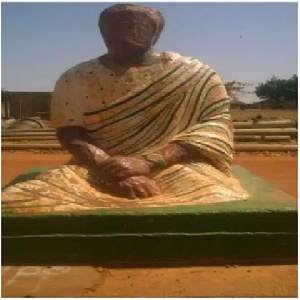 A miniature statue was erected by the Bissa Youth Association in 2002
A miniature statue was erected by the Bissa Youth Association in 2002
As tourism gradually takes centre stage in the country’s foreign exchange earnings, one key touristic attraction that could rake in fortunes for the country but has been neglected is the Kulungugu bomb site.
The historic site is where in the heat of Ghana’s first Republic some disgruntled persons unsuccessfully attempted bombing the first President of Ghana, Osagyefo Dr Kwame Nkrumah.
Since August 1, 1962 when the incident took place at Kulungungu, in the then Upper Region, and now the Pusiga District in the Upper East Region of Ghana, the site has not received any proper attention from the Ministry of tourism even though it has high tourism potentials.
A miniature statue was erected by the Bissa Youth Association in 2002 at the site at Kulungungu to earmark the site for memorial purposes, but it has since been destroyed by thunderstorm and nobody seems to care about it.
The Kulungugu community which is also a frontier between neighbouring Burkina Faso, could be developed into a big tourism attraction site to serve as a revenue base for the Pusiga District Assembly to augment its revenue generation.
The Ghana News Agency (GNA) quest to unearth untapped tourism potentials in the Upper East Region, came to conclusion that the Pusiga District Assembly, the Ghana Tourism Authority, the Ministry of Tourism and the private sector could collaborate to turn the area into a major tourism hap.
Already, the Pusiga District, which was carved from the Bawku Municipality hosts the Naa Gbewaa Shrine; a historic monument that has freezing background and one of the biggest tourist attraction that brought people from neighbouring Burkina Faso, Mali, Togo and the Mamprugu area to observe ancestral sacrifices.
The endowed cultural heritage in the Kusuag area is interconnected as tourists could take advantage to enjoy a holistic and complimentary tourism sites between the Pusiga District and the Bawku Municipality as the latter is also host to attractions such as the Boko Crocodile Pond, and the Wiidi Ecotourism sites and the Samanpiid and Bugum (fire) Festivals.
Mr Yahaya Zanko Bandago former Assembly Member for the Kulungugu Electoral Area who spoke to the GNA at Kulungungu said several efforts to revamp the site by the youth of the area to attract tourists proved futile because, nobody was willing to invest and spearhead the move.
Mr Bandago indicated that the district assembly had been informed on several occasions on the need to revamp the site to generate some revenue, but the local authority has since not responded positively to the proposals anytime it was repeated.
He disclosed that foreign tourist across the world including Russians had come to the area to visit but there was nothing to indicate that this was the area and the spot where the attempt was made to assassinate the first president of Ghana.
Mr Bandago indicated that since the incident formed part of Ghana’s history, there was the need for government to marshal resources and develop the place into a tourism centre just as it has been done for the Mausoleum in Accra “so that school children and researchers could come to know who, how, when, where and why the attempt was made” he emphasised.
He told the GNA that Kwame Nkrumah met the untimely incident when he went to the Upper Volta, now Burkina Faso to settle land disputes between that country and Ghana.
He explained that it was on his return to Ghana that he decided to pass through Kulungungu which was part of the issues when the unfortunate incident occurred.
Naba Zito Abarichi, Chief of the area who is a surviving victim of the bomb attempt said the girl who presented the welcoming flower to the president died shortly after arrival at the hospital, while a boy named Tobazila died on the spot.
Naba Abarichi said many were wounded while others were arrested and detained at the Bawku police station and later transferred to the Navrongo prisons for detention.
He called on government to make the area a place of interest so that people could go there to learn about the consequences of the bomb attempt.